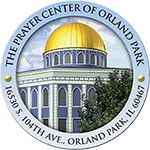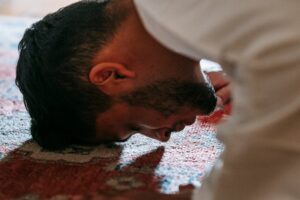Sujud, or prostration, is presented in Quran as a universal phenomenon. Before we talk about Sujud, we should say few words about Ruku’ or bowing. Unlike Sujud, Ruku’ is presented as a unique human phenomenon. Unlike other creatures in this existence, humans have a dual nature capable of choosing between the pathways of obedience and disobedience: “And We have shown him the two pathways.” [90:10]. Humans are given the opportunity to repent and transcend error and mistake. Ruku’ is the act that symbolizes repentance and transcendence. This meaning of Ruku’ can be deduced from the experience of Prophet David as narrated in Quran. Qur’an described Prophet David bowing in “Ruku” asking for forgiveness for misjudging a dispute between two persons: “He asked for forgiveness of his Lord, fell down bowing and turned to Allah in repentance.” [38:24].
Humans share with other creatures the act of Sujud: “And to Allah do prostrate all that is in the heavens and on earth, whether moving creatures or the angels: for none are arrogant.” [16:49]. “See you not that to Allah prostrate all who are in the heavens and on earth- The sun, the moon, the stars, the mountains, the trees, the animals; and a great number among mankind? But a great number are fit for punishment.” [22:18]. This is a very important verse because it shows clearly the difference between the Sujud of humans and its counterpart in other creatures. Sujud is inherent and part of the creation and function of the sun, the moon, the stars, the mountains, the trees, and the animals; in addition to the angels who are always in the state of obedience: “They do not flinch from the commands they receive from Allah, but do what they are commanded.” [66:6].
Sujud in the human realm is a challenge. Humans have the free will to practice Sujud in their journey towards Allah (SWT). The believers are invited to learn from the Universe and the Angels how to perfect their Sujud. In fact, the more they perfect their Sujud and obedience to Allah (SWT), such creatures are more likely to obey them and come to their service. This is best exemplified in the experience of Prophet Yusuf when he narrated to his father, Prophet Jacob, his dream: “Behold, Joseph said to his father: O my father! I saw eleven stars and the sun and the moon: I saw them prostrating to me.” [12:4].
When the believers prostrate before their Lord, they are declaring their total obedience to Him. When the believers put their foreheads on the ground before their Lord, they are liberating themselves from their own egos and everything that may come between them and Allah (SWT), their ultimate goal and Qibla. When the believers practice Sujud, they are breaking the bars of the prison of the self – the strongest prison where the human self is the prison, the prisoner and the guard of the prison at the same time.
The believers realized, as Prophet Mohammad(S) realized, from the early beginning of the message, that Sujud is a process and a journey that should not stop: “But prostrate and bring yourself the closer to Him.” [96:19].
Sujud is the state where the believer is closest to Allah (SWT) as Prophet Mohammad defined it: “The worshipper is closest to his Lord while in Sujud.” Why then does Quran talk about Sujud and bringing oneself closer to Allah?
The act of Sujud must be perpetual, and in our prayer, Sujud is the only act that is done twice in a row. This indicates that we do not reach but we can only approach and get closer. In other words, the second Sujud must be qualitatively better than the first, and the journey towards Allah (SWT) must continue nonstop.
Sujud emerged as an important theme in the world view of Islam regarding the human being, the Universe, and all the manifestations of life. The place or the house of worship will be called masjid or mosque, a name derived from the concept of Sujud: “The mosques of God shall nurture those who believe in God and the Last Day, establish regular prayers, and practice regular charity, and fear none except God. It is they who are expected to be on true guidance.” [9:18].
The switch from “house” to “masjid” was also applied to the Sacred House in Mecca and the Sacred House in Jerusalem. Quran will refer to them as Sacred Mosque and Al-Aqsa Mosque: “Glory to Allah who took His worshipper for a journey by night from the Sacred Mosque to Al-Aqsa Mosque.” [17:1]. Al-Aqsa mosque is a pure Quranic name. Al-Aqsa literally means the farthest. But it should not be understood in terms of distance because Muslims later built more distant mosques beyond Jerusalem. The farthest should be understood as the peak and culmination of values reached by the peak and apogee of prophecy. In fact, Mohammad (S) would lead in prayer all the Prophets and Messengers before him in Al-Aqsa Mosque during the journey of Isra’.
This move is compatible with the universal nature of the Islamic message and the universal concept of Sujud. The believers also act as universal human beings because the social responsibility of the truly prostrating believers extends beyond the physical structure of the mosque in the form of charity, public service, and sincere commitment to humanity. For them, the mosque is the school, the laboratory, and the training center for Sujud. Consequently, the whole earth is transformed into the greatest mosque. As Prophet Mohammad(S) said: “The whole earth has been made a clean place for me to prostrate.”
By Walid Khayr




